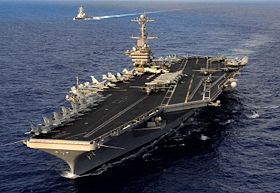December 21, 2018
After a more than eight-month gap, the US Navy has now dispatched an aircraft carrier to the Persian Gulf.

The Wall Street Journal reported December 3 that the USS John C. Stennis was already in the Indian Ocean on its way to the Persian Gulf. The Journal story was published just as an Iranian military officer was boasting that Iran had forced the United States to withdraw from the Persian Gulf, a rather odd statement given that the US Fifth Fleet is based in Bahrain.
The eight-month gap with no US aircraft carrier in the region was the longest such gap in two decades, the Journal said.
The Stennis is scheduled to remain in the region for about two months, officials told the Journal, spending most of that time in the Persian Gulf, which will irritate the Pasdaran maritime forces. Its presence “certainly provides a deterrence” against any potentially hostile Iranian activity in the region’s waters, one official told the Journal.
The absence of a carrier strike group this year was part of a realignment of capabilities away from the Middle East and toward China and Russia, Pentagon officials have said, in keeping with new US strategic goals to focus more on Russia and China.
The Stennis currently is moving through the Indian Ocean. It has been at sea since mid-October and most recently conducted a port visit in Singapore late last month.
Aircraft carriers are the largest warships afloat and a carrier’s presence or absence from the Persian Gulf has always drawn attention. In the early days after the Iranian revolution, that was logical because the United States didn’t have much airpower in the region without an aircraft carrier present.
But that has changed. For many years now, the US Air Force has maintained a huge base at Al-Udeid in Qatar with well over 100 aircraft based there. And those 100 planes can be doubled and tripled within days by additional planes flown in from Europe and the United States. So the presence of a carrier with about 90 planes is not as important today as it was when the US had no aircraft permanently stationed in the Persian Gulf region.
What’s more, modern planes have much greater range. As a result, in the 2003 war against Iraq, B-2 stealth bombers were flown from Whiteman Air Force Base in Missouri to hit targets in Iraq—a 36-hour round trip mission.
In addition, much of any war that would be launched against Iran would be carried out through Tomahawk cruise missiles, the weapon of choice by the US military because of its accuracy, cheapness and invulnerability.
All of this means that the deployment of an aircraft carrier today may still be dramatic, but it is no longer as militarily significant as in the 20th Century.
The very day The Wall Street Journal story appeared on the Stennis heading to the Persian Gulf, Pasdar General Hossain Salami claimed that Iran’s might had forced the Americans to pull their carriers out of the Persian Gulf. He also told an audience in Tehran that the Islamic Revolution had so curtailed American power that US commanders had even announced that US aircraft carriers are now no more than scrap iron. He didn’t seem to know that two US aircraft carriers are currently under construction and two more are planned to go under construction.






















